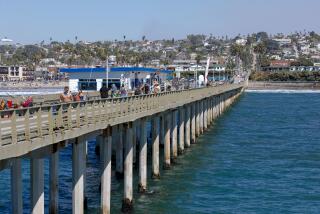L.A. Redux / The City Then and Now
Seven piers have been built at Redondo Beach since the late 1880s, and all but two of them have fallen victim to fierce storms.
The first pier was built in 1889 by Daniel Freeman and his partner, Nathan Russell Vail, at the foot of Emerald Street, where the town center used to be. The structure was destroyed in 1914 by a storm packing 85 m.p.h. winds. Nearly 14 inches of rain fell over a six-week period.
For the record:
12:00 a.m. Aug. 31, 1991 For the Record
Los Angeles Times Saturday August 31, 1991 Home Edition Metro Part B Page 2 Column 5 Metro Desk 2 inches; 59 words Type of Material: Correction
Redondo Beach piers--There were several errors in an article Friday about the history of Redondo Beach piers. The first pier was built in 1889 by Daniel McFarland, Charles Silent and Nathan Russell Vail; Capt. Hans Monstad’s son was named Walter Eugene (Webb) Monstad, and the seventh pier, built in 1961 and privately owned by the Redondo Beach Marina, is north of the Municipal Pier and southwest of the swimming lagoon.
In 1895, another pier was built in front of the Hotel Redondo, where the library and 100-year-old Moreton Bay fig tree stand today. It was partially destroyed during a storm in 1915, patched up and finally torn down in the early 1920s. It had a unique Y-shape, with two prongs coming out from the shore. One was for the railroad and the other for sightseers and fishermen. The prongs rejoined 100 yards out and extended another 60 yards.
The 460-foot Lumber Pier, built just south of Sapphire Street in 1903, endured many storms--but lost a land battle with the wealthy families on Esplanade, the major street along the beach. They complained for years about the traffic, noise and unsightliness created by the ships unloading their lumber on rail cars. The city of Redondo Beach refused to renew the franchise with Pacific Electric Railway in 1923, and the lumber companies threatened to move out of town. The city backed down and renewed the franchise for three years. Then, in 1926, the pier was torn down. The Esplanade homeowners had won.
In 1916, the Endless Pier, also known as the Pleasure Pier, was built for about $165,000 on concrete and steel pilings. One arm of the pier started at Emerald Street and the other at Coral Way (which no longer exists), and joined farther out in the harbor. This pier only lasted until 1919, when another severe storm demolished its central section.
The sweeping Horseshoe Pier (also known as the Municipal Pier or Redondo Beach Pier) was built in 1926, on the same site as the Endless Pier.
Alongside it to the south, Capt. Walter Eugene Monstad, a former Merchant Marine shipper and owner of several fishing barges, built a straight pier in 1928. According to Redondo Beach historian Gloria Snyder, The Rex, a gambling ship, moved to Redondo Beach in May, 1938, and set off a boom at Monstad’s pier. To accommodate the increased business, Monstad added 100 feet to his pier and a waiting room for the 1,500 customers that came out at night for the 25-cent water taxi ride to the Rex.
Less than a year later, Monstad’s son, Hans, anchored his own gambling ship the Monte Carlo, 3 1/2 miles offshore to cash in on the gambling profits. In 1939, federal agents raided the offshore gaming ships. Disheartened after several business failures, the elder Monstad, 70, hanged himself the same year.
In January, 1988, a storm caused $17 million in damage to the harbor. On April 30, waves demolished the seventh pier, built in 1984, that connected the Redondo Beach Pier to Monstad’s Pier. Then on May 27, an electrical fire that started in one of the restaurants ravaged much of the pier complex, causing about $7 million in damage and destroying 15 businesses. Two days later, high waves again battered the pier, knocking out most of what had remained of the fire-ravaged section and further damaging the northern leg of the horseshoe pier and the restaurant on top of it.
The Redondo Beach City Council next month will consider spending $7.4 million for reconstruction. If approved, rebuilding will begin next spring.
More to Read
Sign up for Essential California
The most important California stories and recommendations in your inbox every morning.
You may occasionally receive promotional content from the Los Angeles Times.









